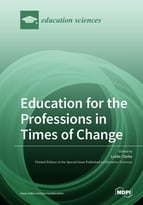Education for the Professions in Times of Change
A special issue of Education Sciences (ISSN 2227-7102).
Deadline for manuscript submissions: closed (30 September 2019) | Viewed by 45336
Special Issue Editor
Special Issue Information
Dear Colleagues,
We would like to propose a Special Education, which is focused on a critical appraisal of the learning and status of professionals at a time when distrust and dismissal of professional expertise is a significant trend and where accountability and commodification agendas are impinging daily on the status and roles of professionals. Increasingly, education for the professions is based in universities, yet academy is increasingly accused of credentialism, even whilst the career trajectories of academics themselves can be all too precarious. At the same time it is important to acknowledge that ‘Profession’ is itself a slippery and overused term, imbued with overtones of both high status expertise and conspiratorial exclusivity, yet sufficiently elastic to ‘cover’ both the ‘professional’ footballer and his/her ‘professional’ foul. This Special Issue will feature both theory-based think pieces and studies based on primary data.
Prof. Linda Clarke
Guest Editor
Manuscript Submission Information
Manuscripts should be submitted online at www.mdpi.com by registering and logging in to this website. Once you are registered, click here to go to the submission form. Manuscripts can be submitted until the deadline. All submissions that pass pre-check are peer-reviewed. Accepted papers will be published continuously in the journal (as soon as accepted) and will be listed together on the special issue website. Research articles, review articles as well as short communications are invited. For planned papers, a title and short abstract (about 100 words) can be sent to the Editorial Office for announcement on this website.
Submitted manuscripts should not have been published previously, nor be under consideration for publication elsewhere (except conference proceedings papers). All manuscripts are thoroughly refereed through a double-blind peer-review process. A guide for authors and other relevant information for submission of manuscripts is available on the Instructions for Authors page. Education Sciences is an international peer-reviewed open access monthly journal published by MDPI.
Please visit the Instructions for Authors page before submitting a manuscript. The Article Processing Charge (APC) for publication in this open access journal is 1800 CHF (Swiss Francs). Submitted papers should be well formatted and use good English. Authors may use MDPI's English editing service prior to publication or during author revisions.
Keywords
- Professions
- Professionalism
- The Place Model






